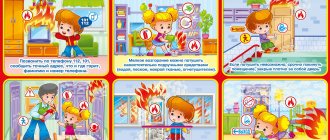Publications about the preparation and conduct of classes on fire safety. We strengthen children's knowledge about the causes of fires, safety rules at home and on the street. We form ideas about the benefits and harms of fire. We teach children to find the right way out of dangerous situations. We systematize their knowledge about what burns and what doesn’t burn. We make children want to be careful with fire always and everywhere. We cultivate responsibility for ourselves and for the lives of our loved ones. See what ways your colleagues have found to present material on fire safety in an entertaining way.
Introduction
Fire safety is one of the components of ensuring the national security of the country. A high level of fire safety is an integral component of the high level of socio-economic development of the Russian Federation. Fires cause significant material damage in all sectors of the national economy, leading to injuries and deaths.
In the Russian Federation, more than 130 thousand fires are recorded annually, as a result of which more than 8 thousand people die, the total losses amount to more than 100 billion rubles. The main causes and objects of fires are presented in the figure below.
The most important and obvious fire safety problem to be resolved, along with increasing the efficiency of the actions of fire departments of various types, is also increasing the effectiveness of preventive fire prevention measures and measures taken by citizens and owners to protect property from fire. Correct and timely work in this direction should have an important socio-economic effect in the form of voluntary and comprehensive compliance with fire safety requirements both personally by citizens and by enterprises, institutions and organizations within the framework of official or public activities.
Achieving this global goal is possible only if a high level of training is provided to the country's population in fire safety measures , which, in accordance with Article 1 of the Federal Law of December 21, 1994 No. 69-FZ “On Fire Safety” [1] refers to actions to ensure fire safety, including compliance with fire safety requirements. At the same time, fire safety requirements are special conditions of a social and (or) technical nature established in order to ensure fire safety by the legislation of the Russian Federation, regulatory documents or an authorized state body [1].
A special role in this process is given to managers and persons responsible for ensuring fire safety of organizations, who not only formulate the organization’s policy in the field of fire safety, develop and implement fire safety measures for a specific enterprise, but also have the right to independently train the rest of the employees of this enterprise in measures fire safety as part of fire safety instructions.
This course is intended for managers and persons responsible for ensuring fire safety in institutions (offices).
Fire safety: training for organizational leaders
Managers of organizations are required to undergo PTM training and instructions, regardless of whether the enterprise is an explosion hazard or not.
PTM training is mandatory for the following managers:
- managers and chief specialists of the organization or persons performing their duties;
- employees responsible for fire safety of organizations and conducting fire safety training;
- heads of primary organizations of voluntary fire protection and other senior employees by decision of the head of the organization.
The head of the organization has the right to appoint persons who, by virtue of their position or the nature of the work performed, are responsible for ensuring fire safety at the protection facility. The responsibilities of the person responsible must be enshrined in local regulations. Such an employee will be responsible for conducting fire safety training and enter into an agreement with the training organization for advanced training under the PTM program.
Main causes of fires
To successfully carry out fire prevention in enterprises, it is important to know the main causes of fires. Based on statistical data, we can conclude that the main causes of fires in production are:
— careless handling of fire;
— unsatisfactory condition of electrical devices and violation of the rules for their installation and operation;
— violation of technological process regimes;
— malfunction of heating devices and violation of the rules of their operation;
— failure to comply with the requirements of regulatory documents on fire safety issues.
Very often, industrial fires occur due to careless handling of fire. This usually means smoking in prohibited places and performing so-called hot work. Hot work is considered to be production operations involving the use of open fire, sparking and heating of parts, equipment, structures to temperatures capable of causing ignition of flammable substances and materials, vapors of flammable liquids. Hot work includes: gas and electric welding, gasoline and gas cutting, soldering work, cooking bitumen and resin, mechanical processing of metal with the formation of sparks.
Places for hot work can be permanent or temporary. Permanent places are determined by order of the head of the enterprise, and temporary places - by written permission of the head of the department. In accordance with fire safety requirements, there should be no flammable materials at the hot work sites within a radius of at least 5 m. It must be borne in mind that gas welding uses substances (acetylene, methane, oxygen) that increase the risk of fire and explosion.
Performers of work (electric and gas welders, soldering irons, resin cookers, etc.) must be instructed about fire safety measures by the persons responsible for this.
Before carrying out temporary fire work, fire safety measures are developed, the fire department is notified, persons responsible for ensuring fire safety are appointed, and after that a signed permit for the work is issued. This permission is given for one shift. After finishing hot work, the welder is obliged to inspect the work site and pour water on the combustible structures. The hot work site must be checked repeatedly within 2 hours after completion of work. Before welding a container in which liquid fuel or flammable gases were stored, it should be cleaned, washed with hot water and caustic soda, steamed, dried, ventilated, and an air analysis done. When welding, hatches and caps of the container must be open.
Responsibility for fire safety measures during welding and other hot work rests with the managers of sections, workshops, and enterprises.
According to statistics, fires that occur as a result of the unsatisfactory condition of electrical devices and violation of the rules for their installation and operation account for more than 25% of all cases, and depending on the causes, they are distributed as follows: about 45% occur due to short circuits, 35% - from electric heating devices, 13% - from overload of electric heaters and networks, 5% - from high transient resistances. Short circuits occur due to improper installation or operation of electrical installations, aging or damaged insulation. The short circuit current depends on the power of the current source, the distance from the current source to the fault location and the type of fault. Short circuits cause genuine heating of conductive parts, which can result in ignition of the insulation of conductors and combustible building structures. Overloads in electrical networks occur when additional consumers are connected to the network or when the voltage in the network decreases. Due to a significant increase in current consumption, excessive heating of the conductors occurs, which can cause fires.
An increase in local transient resistance occurs due to oxidation or insufficiently tight connection of the contacts of electrical machines. The resulting spark may start a fire. To prevent fire from high transition resistances, copper wires and cables are connected by twisting the cores and then soldering them. Aluminum cables are connected with sleeves.
The choice of electrical wiring diagrams, materials used, cross-sectional area of conductors and cables, type of insulation depends on the degree of fire hazard of the environment, operating mode of electrical installations and possible overloads: The cross-sectional area of conductors is selected according to the norms of permissible current loads and voltage drop in the network. Maximum current loads are given in special tables, taking into account the possible heating of conductors to a temperature of no more than 55 °C.
Fire safety training program: who develops it and based on what documents
Introductory and primary fire safety training programs must be developed and approved by the head of the organization. Repeated briefings are carried out according to the initial briefing program. Instructions in the organization are carried out by persons appointed responsible for ensuring fire safety.
Instructions on fire safety measures are drawn up in accordance with the requirements established by Section XVIII of the PPR, taking into account the specifics of explosion- and fire-hazardous premises in the specified buildings and structures.
A training program in the scope of PTM is developed by training organizations and approved by the territorial departments of the Russian Ministry of Emergency Situations.
For workers in explosion- and fire-hazardous industries, it is mandatory to include training at testing sites in the PTM program. Therefore, it is impossible to conduct training in PTM for such industries exclusively in theoretical and especially in distance form. To do this, the training organization needs to develop a training ground.
Fire prevention tasks
To ensure fire safety of enterprises during their design, construction and operation, fire prevention measures must be planned and implemented, which can be divided into groups:
- Measures aimed at preventing fire (eliminating direct or indirect causes of its occurrence):
— selection of technological processes, materials, equipment, modes of conducting processes and operating equipment, taking into account fire hazards, including the use of non-flammable and low-flammable materials and substances instead of fire hazardous ones;
— appropriate selection and installation of heating and ventilation systems, use of electrical equipment and lamps corresponding to the fire and explosion hazard class of the premises, group and category of explosive mixture;
— elimination of conditions for spontaneous combustion of substances and materials;
— application of measures to combat static electricity discharges and other types of sparking;
— establishing the maximum permissible heating temperature of equipment surfaces, flammable substances, materials, structures.
- Measures aimed at limiting the size and spread of a fire beyond its source:
— appropriate placement of production, buildings and structures on the territory of the facility;
— appropriate placement and layout of production workshops and areas, selection of building structures with the required fire resistance limits, taking into account the fire and explosion hazard of production processes;
— limiting the amount of flammable substances simultaneously present in the room;
— isolation of a flammable environment (sealing of equipment and containers with flammable substances), placement of fire-hazardous processes and equipment in isolated rooms;
- establishment of permissible areas of production compartments and sections, installation of fire barriers - walls, zones, protective strips, fire-resistant floors, doors, partitions, use of fire-retarding devices, non-combustible and low-combustible structural elements of buildings and structures, impregnation of combustible structures with fire retardants to increase their fire resistance;
— installation of automatic fire alarms and use of fire extinguishing means, including automatic ones.
The main tasks of fire prevention:
- organizing and monitoring the fire safety condition of the facility;
- development and implementation of fire safety measures;
- monitoring compliance with fire safety requirements;
- development of proposals for fire prevention;
- training in fire safety measures and actions in case of fire;
- conducting fire prevention propaganda; monitoring the condition and performance of fire protection systems and means.
Fire regulations in the Russian Federation
The fire safety regime within the Russian Federation is regulated by law. For this purpose, Federal laws, Decrees of the Government and the Ministry of Emergency Situations of the Russian Federation, Fire Safety Standards have been developed and approved, which in many provisions contradict each other or do not contain complete information on a particular issue. Since April 25, 2012, for organizations of the Russian Federation of all forms of ownership and types of activity, the Fire Safety Rules, approved by Decree of the Government of the Russian Federation No. 390, have been in effect.
The introduction of a fire safety regime at enterprises is necessary in order not only to train people in the correct actions in case of fire, but also how to safely carry out their work functions within the territory of the organization, thereby avoiding fires and their consequences.
Definition, purpose
In order to avoid fires in the territories of organizations, settlements, social and cultural objects and when performing fire-hazardous work, every citizen is obliged to know and apply fire safety rules in practice. Resolution No. 390 defines what a fire safety regime is.
Actions of citizens, workers, heads of commercial and social organizations, which are aimed at eliminating all possible causes of fire - these are the rules of the fire safety regime in the Russian Federation. The same document contains guidance in case failure to comply with any requirement leads to a fire.
Introduction of a special fire regime
A special fire regime is a period when, throughout the entire territory of a constituent entity of the Russian Federation, careful compliance with norms and rules aimed at preventing fires is required. This period is introduced by local governments based on fire statistics for previous years, meteorological conditions and the situation in a certain area of a constituent entity of the Russian Federation, for example, the occurrence of large forest fires.
During the fire danger period, a fire safety regime is introduced
The rules of the fire regime in the Russian Federation require, before the introduction of a special situation, the organization of a commission for the prevention and liquidation of emergencies in the designated territory of a constituent entity of the Russian Federation, which will make a decision on this issue.
The fire regime is a special period that is introduced in the presence of the following conditions in a separately designated area:
increasing statistics on the occurrence of fires in the residential sector;
there was a fire or several fires that resulted in significant public outcry;
squally winds with a speed of 30 m/s or more, as well as air temperatures above 30 degrees Celsius throughout the calendar week;
forest fires lasting 2 or more days.
As soon as one of the above conditions arises, the commission issues a decision - an order on the fire safety regime, which contains the following data:
reasons for introducing a special fire regime;
recommendations for maintaining the required level of fire safety throughout the dangerous period;
a set of measures with which you can quickly restore the territory and eliminate the causes that may contribute to the occurrence of fires;
standards for the work of the fire department for this period;
algorithm for monitoring the fulfillment of order requirements.
The average duration of the fire regime is from 14 to 90 days, it depends on the situation in the locality, as well as on the level of implementation of fire safety measures. If the commission decides to lift the regime, then an order is issued to cancel it.
Compliance with increased safety requirements during fire danger also applies to organizations of all forms of ownership, especially those serving the social sphere. For this purpose, each organization appoints a person responsible for fire safety. At the same time, an order is issued to organize a fire safety regime in the organization. The document specifies the requirements that must be observed in order to avoid fires on the territory of a particular legal entity and in its buildings, structures, and premises.
Local governments are planning to attract additional forces and resources to eliminate fires and prevent their occurrence, and to finance these activities:
payment for modernized fire fighting equipment, machines, devices for fire extinguishing needs;
remuneration for firefighters who work in conditions of increased risk to their lives.
The technical part of fire protection measures in hazardous areas consists of the following elements:
Informing the population through telecommunications.
Bringing existing water-carrying equipment into readiness mode.
Patrolling of the populated area by employees of the voluntary fire brigade for fires.
Installation of water containers near residential buildings.
Explanatory work with citizens by visiting residential apartments and houses.
Prohibition on carrying out fire-hazardous work, firing furnaces and boiler rooms.
Fencing the forest area from unauthorized persons.
Removing dried vegetation.
Construction of fire protection strips along forest areas.
Hiring public transport in case of emergency evacuation of residents and material assets.
Organization of round-the-clock duty of voluntary squads in production organizations, providing them with primary fire extinguishing means.
Rights, duties, responsibilities for ensuring fire safety.
Rights and obligations of organizations in the field of fire safety (Article 37 No. 69-FZ):
The heads of the organization have the right:
create, reorganize and liquidate in the prescribed manner fire departments, which they maintain at their own expense;
make proposals to state authorities and local governments to ensure fire safety;
carry out work to establish the causes and circumstances of fires that occurred at enterprises;
establish measures of social and economic incentives to ensure fire safety;
receive information on fire safety issues, including in the prescribed manner from management bodies and fire departments.
The leaders of the organization are obliged:
comply with fire safety requirements, as well as comply with orders, regulations and other legal requirements of fire officials;
develop and implement measures to ensure fire safety;
conduct fire prevention propaganda, as well as train their employees in fire safety measures;
include fire safety issues in the collective agreement (agreement);
maintain fire protection systems and means, including primary fire extinguishing means, in good condition, and prevent their use for other purposes;
provide assistance to fire protection in extinguishing fires, establishing the causes and conditions of their occurrence and development, as well as in identifying persons guilty of violating fire safety requirements and causing fires;
provide, in accordance with the established procedure, the necessary forces and means when extinguishing fires on the territories of enterprises;
provide access to fire officials when performing their official duties on the territory, buildings, structures and other facilities of enterprises;
provide, at the request of state fire supervision officials, information and documents on the state of fire safety at enterprises, including the fire hazard of the products they produce, as well as fires that occurred on their territories and their consequences;
immediately report to the fire department about fires, malfunctions of existing systems and fire protection equipment, changes in the condition of roads and passages;
promote the activities of volunteer firefighters;
ensure the creation and maintenance of fire protection units at facilities based on the requirements established by Article 97 of Federal Law No. 123-FZ of July 22, 2008 “Technical Regulations on Fire Safety Requirements.”
Fire safety training for employees of organizations
In addition to the types of training indicated in Table 1, from January 1, 2021, at a protection facility with a large gathering of people, of persons operating at a protection facility with a large gathering of people, as well as visitors, is carried out at least once every six months , buyers, other persons located in the building, structure.. This is specified in paragraph 9 of the PPR.
If everything is more or less clear with instructions and training, then with training it is necessary to carefully understand. It’s one thing to conduct such training once every six months with your staff. But what to do if your enterprise is a facility with a large number of people who are not necessarily your full-time employees?
Important information. Objects where people stay in large numbers include objects where, according to design documentation, more than 50 people can be present at the same time, and (or) more than 10 workplaces are organized. If there is no standard defining the maximum permissible number of people in a room, you should proceed from the calculation of no more than 1 person per 1 sq. m. m.
During practical training, it is necessary to practice the evacuation of not only personnel, but also visitors - patients, clients, buyers, tourists, contractors, trainees.
Fundamental changes have also occurred in the procedure for carrying out the fire-technical minimum. We remind you that training under the fire-technical minimum program (hereinafter referred to as PTM), from January 1, 2021, must be conducted in organizations licensed to conduct additional professional education.
Article 76 of the Federal Law of December 29, 2012 N 273-FZ “On Education in the Russian Federation” “2. Additional professional education is carried out through the implementation of additional professional programs (programs for advanced training and professional retraining programs)"
If professional retraining is mandatory for employees holding the position of fire prevention specialist or instructor, then advanced training is necessary for all employees subject to training under the PTM program . The frequency of training under such a program is annually for explosion- and fire-hazardous industries, and once every 3 years for other industries. Who exactly is subject to PTM training is indicated in Table 2.
Table 2. Comparative analysis of fire safety minimum requirements
| Until January 1, 2021 | From January 1, 2021 |
| Clause 36 of NPB 645. Training in fire-technical minimum according to special programs developed and approved in the prescribed manner with a break from production pass: · managers and chief specialists of the organization or persons performing their duties; · employees responsible for fire safety of organizations and conducting fire safety training; · heads of primary organizations of voluntary fire protection; · managers of country health institutions for children and adolescents; · workers performing gas-electric welding and other hot work; · drivers of fire trucks and mechanics of motor pumps of children's health institutions; · other categories of employees (citizens) by decision of the manager. | Clause 3 of the PPR. Training of all specified categories of workers must be carried out in organizations licensed to conduct additional professional education. The procedure and timing of training individuals in fire safety measures is determined by the head of the organization, taking into account the requirements of regulatory legal acts of the Russian Federation. |
| Paragraph 39 of NPB 645. According to special fire-technical minimum programs developed and approved in accordance with the established procedure directly to the organization are trained: · heads of departments of the organization, managers and chief specialists of departments of fire and explosion hazardous industries; · employees responsible for ensuring fire safety in departments; · teaching staff of preschool educational institutions; · workers providing 24-hour security for the organization; · citizens participating in the activities of fire departments to prevent and (or) extinguish fires on a voluntary basis; · workers involved in performing explosion and fire hazardous work. |
We remind you that in accordance with Article 196 of the Labor Code of the Russian Federation, the employer himself determines which of his employees is subject to advanced training, taking into account the requirements of the law . And the employer will also bear responsibility for the wrong decision, including criminal liability. Therefore, in the local regulations on fire safety training, it is necessary to indicate which positions and professions in your specific organization are subject only to instruction, and which, in addition to instruction, must be trained in fire safety equipment at a training center, and who must have professional retraining (if there is no specialized training).
You need to reason according to the following algorithm:
- Does the employee carry out explosion and fire hazardous work, including one-time work? The accountant does not conduct. Therefore, all he needs is instruction and training. Welder - conducts. He needs PTM, instructions and training.
- Is there a position in the staffing table “Fire Prevention Specialist” or with another title that implies organizing and ensuring fire safety at the enterprise? If there is, such an employee must have professional training, and in its absence, professional retraining for compliance with the professional standard of October 28, 2014 No. 814n.
- If there is no position on staff that involves organizing and ensuring fire safety, but the employee, according to his job function or on the instructions of management, organizes safe work, carries out fire-hazardous work, ensures the fire safety regime of the enterprise, he needs to conduct briefings, training and improve his qualifications under the PTM program.
Examples will help you navigate the changes, as well as better understand which of the company’s employees should be sent to a training center for PTM training, and who should have professional retraining.
Example No. 1
NPO Altair LLC has a fire prevention specialist on its staff. A university graduate who already has a qualification as a fire safety engineer is hired for this job. Therefore, he does not need to carry out either professional retraining or advanced training under the PTM program, since he is ALREADY a professional. But no one exempted him from all types of fire safety training.
Example No. 2
Naiads and Mermaids LLC has a fire prevention specialist on its staff. It was decided to transfer the garage manager to this job. The garage manager has a secondary vocational education as an auto mechanic. But he has no professional education in fire safety. Therefore, he needs to undergo professional retraining in fire safety, but after that he will not need to carry out advanced training under the PTM program, since after undergoing professional retraining he has become a professional. It is necessary to conduct all types of fire safety training with this employee.
Since the initiative for professional retraining comes from the employer himself, it is the employer, not the employee, who pays for such training. Training time will also be paid by the employer. You can add a condition in the additional agreement to the employment contract regarding the need to work for a certain period of time. Otherwise, it turns out that the employee was trained, but he immediately moved to another employer, that is, unnecessary expenses occurred.
Example No. 3
JSC Znatnye Pirogi does not have a full-time fire prevention specialist. The director appointed the chief engineer, who has a “confectionery” education, to be responsible for ensuring fire safety at the enterprise. He does not need to undergo professional retraining, since there is no position on staff. In this case, it is enough to organize advanced training under the PTM program and all types of instructions at the employer’s expense.
Example No. 4
An accountant at MKU "Roads of Russia" decided to undergo professional retraining in fire safety in order to find a job as a fire prevention instructor. Since the initiative comes from the employee, she will undergo professional retraining at her own expense and in her free time. Since the employer did not establish the need to undergo fire safety procedures in the current position, only fire safety briefings should be carried out with the accountant.
LITERATURE
- Federal Law of December 21, 1994 No. 69-FZ “On Fire Safety”;
- Federal Law of July 22, 2008 No. 123-FZ “Technical Regulations on Fire Safety Requirements”;
- Federal Law of December 26, 2008 No. 294-FZ “On the protection of the rights of legal entities and individual entrepreneurs in the exercise of state control (supervision) and municipal control”;
- Decree of the Government of the Russian Federation dated April 25, 2012 No. 390 “On the fire safety regime” (together with the “Fire safety regulations in the Russian Federation”).
What has changed in fire safety training in 2021
The organization of fire safety training is the responsibility of each employer. Government Decree No. 1479 of September 16, 2020 approved new Fire Regulations (hereinafter referred to as FPR). Paragraph 3 of the new rules states that workers can be allowed to work only after they have completed fire safety training.
The new Fire Safety Rules provide two forms of training:
- fire safety training
- additional professional education programs
This means that training under the fire-technical minimum program (hereinafter referred to as PTM), previously conducted in one’s organization for certain categories of employees, will cease as of January 1, 2021 for employers who do not have a license for additional professional education.
Note! This contradicts paragraph 35 of the Fire Safety Standards “Training fire safety measures for employees of organizations”, approved by Order of the Ministry of Emergency Situations No. 645 of December 12, 2007 (hereinafter referred to as NPB 645), which states that fire safety training is organized both separately and and without interruption from production.
NPB 645 is included in the List of regulatory legal acts and groups of regulatory legal acts containing mandatory requirements for which the provisions of parts 1, 2 and 3 of Article 15 of the Federal Law “On Mandatory Requirements in the Russian Federation” do not apply, approved by Decree of the Government of the Russian Federation dated 31 December 2021 No. 2467. The validity period of item 479 in the specified List is until September 1, 2021. From September 1, 2021, it is mandatory to conduct PTM in a licensed training organization.
Now, from September 1, 2021, the inspector will check whether such training has been completed in the organization of additional vocational training.







